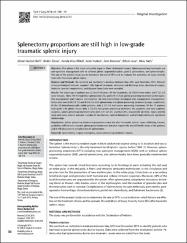| dc.contributor.author | Belli, Ahmet Korkut | |
| dc.contributor.author | Özcan, Önder | |
| dc.contributor.author | Elibol, Funda Dinç | |
| dc.contributor.author | Yazkan, Cenk | |
| dc.contributor.author | Dönmez, Cem | |
| dc.contributor.author | Acar, Ethem | |
| dc.contributor.author | Nazlı, Okay | |
| dc.date.accessioned | 2020-11-20T14:50:05Z | |
| dc.date.available | 2020-11-20T14:50:05Z | |
| dc.date.issued | 2018 | |
| dc.identifier.issn | 2564-6850 | |
| dc.identifier.issn | 2564-7032 | |
| dc.identifier.uri | https://doi.org/10.5152/turkjsurg.2018.3735 | |
| dc.identifier.uri | https://app.trdizin.gov.tr//makale/TWprd016VTVPUT09 | |
| dc.identifier.uri | https://hdl.handle.net/20.500.12809/1450 | |
| dc.description | 0000-0001-8252-3339; 0000-0002-3979-4413 | en_US |
| dc.description | WOS: 000440304500007 | en_US |
| dc.description | PubMed ID: 30023973 | en_US |
| dc.description.abstract | Objective: The spleen is the most vulnerable organ in blunt abdominal trauma. Spleen-preserving treatments are non-operative management with or without splenic angioembolization, partial splenectomy, and splenorrhaphy. The aim of the present study was to determine the rate of SPTs and to evaluate the usefulness of Injury Severity Score after traumatic splenic injury. Material and Methods: We searched our institution's database between May 2012 and December 2015. Patients' clinicopathological features, surgeon's title, type of treatment, admission and discharge dates, duration of surgery, intensive care unit requirement, and Glasgow Coma Scale were recorded. Results: The mean age of patients was 33.36 +/- 11.58 years. Of the 33 patients, 26 (78.8%) were males, and 7 (21.2%) were females. Thirty (90.9%) had total splenectomy (TS), and 3 (9.1%) had spleen preserving treatment (2 Nonoperative management and 1 partial splenectomy). No fatal hemorrhage developed after nonoperative management. Exitus rates were 5/30 (15.1%) and 0/3 in the total splenectomy and spleen preserving treatment groups, respectively. Of the 18 hemodynamically stable patients, only 2 (11.1%) had spleen preserving treatment. Of the 19 patients with grade I-III splenic injury, only 3 (15.8%) had spleen preserving treatment. For academic and non-academic surgeons, spleen preserving treatment rates were 3/11 (27.3%) and 0/22 (0%), respectively (p<0.05). Injury severity score and mean arterial pressure, number of transfusions, control hematocrit, and GCS had statistically significant relationships. Conclusions: Spleen preserving treatment proportions were low after traumatic splenic injury. Following trauma, guidelines will not only improve spleen preservation rates but also improve the overall health status of the patients and it will also prevent complications of splenectomy. | en_US |
| dc.item-language.iso | eng | en_US |
| dc.publisher | Aves | en_US |
| dc.item-rights | info:eu-repo/semantics/openAccess | en_US |
| dc.subject | Splenectomy | en_US |
| dc.subject | Surgery | en_US |
| dc.subject | Emergency | en_US |
| dc.subject | Spleen-Preserving Treatment | en_US |
| dc.subject | Trauma | en_US |
| dc.title | Splenectomy proportions are still high in low-grade traumatic splenic injury | en_US |
| dc.item-type | article | en_US |
| dc.contributor.department | MÜ, Tıp Fakültesi, Cerrahi Tıp Bilimleri Bölümü | en_US |
| dc.contributor.department | MÜ, Tıp Fakültesi, Dahili Tıp Bilimleri Bölümü | |
| dc.contributor.institutionauthor | Belli, Ahmet Korkut | |
| dc.contributor.institutionauthor | Özcan, Önder | |
| dc.contributor.institutionauthor | Elibol, Funda Dinç | |
| dc.contributor.institutionauthor | Yazkan, Cenk | |
| dc.contributor.institutionauthor | Dönmez, Cem | |
| dc.contributor.institutionauthor | Acar, Ethem | |
| dc.contributor.institutionauthor | Nazlı, Okay | |
| dc.identifier.doi | 10.5152/turkjsurg.2018.3735 | |
| dc.identifier.volume | 34 | en_US |
| dc.identifier.issue | 2 | en_US |
| dc.identifier.startpage | 106 | en_US |
| dc.identifier.endpage | 110 | en_US |
| dc.relation.journal | Turkish Journal of Surgery | en_US |
| dc.relation.publicationcategory | Makale - Uluslararası Hakemli Dergi - Kurum Öğretim Elemanı | en_US |


















